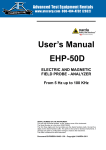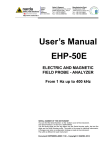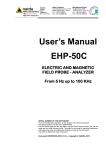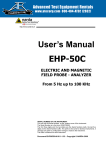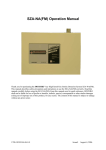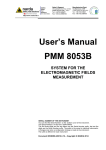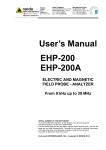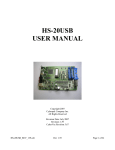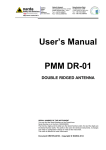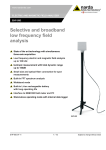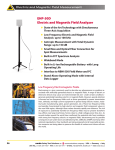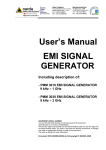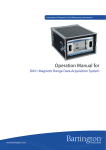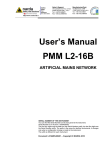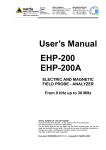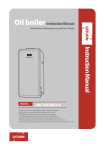Download User`s Manual EHP-50D
Transcript
NARDA
Safety
Test
Solutions
S.r.l. Socio Unico
Sales & Support:
Via Leonardo da Vinci, 21/23
20090 Segrate (MI) - ITALY
Tel.: +39 02 2699871
Fax: +39 02 26998700
Manufacturing Plant:
Via Benessea, 29/B
17035 Cisano sul Neva (SV)
Tel.: +39 0182 58641
Fax: +39 0182 586400
http://www.narda-sts.it
User’s Manual
EHP-50D
ELECTRIC AND MAGNETIC
FIELD PROBE - ANALYZER
From 5 Hz up to 100 kHz
SERIAL NUMBER OF THE INSTRUMENT
You can find the Serial Number on the bottom cover of the instrument.
The Serial Number is in the form: 000XY00000.
The first three digits and the two letters are the Serial Number prefix, the last five
digits are the Serial Number suffix. The prefix is the same for identical instruments,
it changes only when a configuration change is made to the instrument.
The suffix is different for each instrument
Document EHP50DEN-40908-1.59 – Copyright © NARDA 2014
NOTE:
® Names and Logo are registered trademarks of Narda Safety Test Solutions GmbH and L3 Communications
Holdings, Inc. – Trade names are trademarks of the owners.
If the instrument is used in any other way than as described in this Users Manual, it may become unsafe
Before using this product, the related documentation must be read with great care and fully understood to
familiarize with all the safety prescriptions.
To ensure the correct use and the maximum safety level, the User shall know all the instructions and
recommendations contained in this document.
This product is a Safety Class III instrument according to IEC classification and has been designed to meet
the requirements of EN61010-1 (Safety Requirements for Electrical Equipment for Measurement, Control and
Laboratory Use).
In accordance with the IEC classification, the battery charger of this product meets requirements Safety Class
II and Installation Category II (having double insulation and able to carry out mono-phase power supply
operations)..
It complies with the requirements of Pollution Class II (usually only non-conductive pollution). However,
occasionally it may become temporarily conductive due to condense on it.
The information contained in this document is subject to change without notice.
KEY TO THE ELECTRIC AND SAFETY SYMBOLS:
You now own a high-quality instrument that will give you many years of reliable service.
Nevertheless, even this product will eventually become obsolete. When that time
comes, please remember that electronic equipment must be disposed of in accordance
with local regulations. This product conforms to the WEEE Directive of the European
Union (2002/96/EC) and belongs to Category 9 (Monitoring and Control Instruments).
You can return the instrument to us free of charge for proper environment friendly
disposal. You can obtain further information from your local Narda Sales Partner or by
visiting our website at www.narda-sts.it .
Warning, danger of electric shock
Earth
Read carefully the Operating Manual and its
instructions, pay attention to the safety symbols.
Unit Earth Connection
Earth Protection
Equipotential
KEY TO THE SYMBOLS USED IN THIS DOCUMENT:
The DANGER sign draws attention to a potential risk to a person’s
DANGER safety. All the precautions must be fully understood and applied before
proceeding.
WARNING
The WARNING sign draws attention to a potential risk of damage to the
apparatus or loss of data. All the precautions must be fully understood
and applied before proceeding.
CAUTION
The CAUTION sign draws attention against unsafe practices for the
apparatus functionality.
NOTE:
II
The NOTE draw attention to important information.
Note and symbols
Contents
Safety requirements and instructions…..........…….....………
EC Conformity Certificate…............................………………...
Page
VI
VII
1 General information
1.1 Documentation......................................................….……….
1.2 Introduction ……………….....................………………………
1.3 Configuration and Standard accessories...............................
1.4 Optional accessories ..............................................…………
1.5 Main specifications.................................................………….
1.6 Isotropic E&H field analyzer EHP-50D typical uncertainty
and Anisotropy…………………………………………………..
1.6.1 Typical uncertainty of EHP-50D……………………………..
1.6.2 Explication Notes……………………………………………...
1.7 Anisotropy………………………………………………………..
1.8 EHP-50D panel...................................………..………………
Page
1-1
1-1
1-3
1-3
1-4
1-5
1-5
1-6
1-7
1-8
2 Software interface
2.1 Introduction…………….........................................…...……..
2.2 Preliminary inspection…….............................……...………
2.3 Work Environment………..........................…………..………
2.4 To return for repair…..…..................................……...………
2.5 Equipment cleaning………..…….….................……...………
2.6 Power supply and battery recharging………………………...
2.7 EHP-50D connected to a PC………………………………….
2.8 EHP-50D stand alone mode….….…………………….………
2.9 EHP-50D with NBM-550…….…………………………………
2.10 Battery management…………….……………………………
2.11 Avoiding measurement errors………………………………..
Page
2-1
2-1
2-1
2-1
2-1
2-2
2-3
2-3
2-3
2-3
2-4
3 EHP-TS installation
3.1 Introduction…………………………………………………..….
3.2 Hardware requirements…………………………...………..….
3.3 Installing EHP-TS Software………….………………..……….
Page
3-1
3-1
3-2
4 USB-OC Installation
4.1 USB-OC Optical to USB Converter driver installation….…...
4.2 Hardware installation..................…………………………..….
4.3 COM Port setting with 8053-OC………………………………
Page
4-1
4-6
4-7
5 EHP-TS software
5.1 EHP-TS Applications……………………………………………
5.2 EHP-50D Applications……….....…………………………..….
5.2.1 Main menù………………….………………………………….
5.3 Sweep section……………………………………………………
5.4 Data section……………...………………………………………
5.4.1 Waterfall………………………………………………………..
5.4.1.1 Data recording……………………………………………….
5.5 Mode section……………………………………………………..
5.6 Limit section………………………………………………………
5.7 Appearance section……………………………………………..
5.8 ICNIRP…………………………………………….………………
5.9 IEEE………..……………………………………………………...
5.10 Additional functions provided by EHP200-TS……………….
Page
5-1
5-2
5-2
5-4
5-6
5-8
5-12
5-13
5-14
5-16
5-17
5-19
5-21
Contents
III
6 EHP-50D Stand alone mode
6.1 Stand alone mode description………….………………….….
6.2 EHP-50D Data Logger………………………………………….
6.2.1 Run EHP-50D Logger………………………………………..
6.2.2 Use EHP-50D Logger………………………………………..
6.2.3 EHP-50D battery charging…………………………………..
Page
6-1
6-2
6-2
6-5
6-5
7 Update Firmware
7.1 Update firmware…………..…………………………………….
7.2 To run the update software..…………………………………..
7.3 To transfer data ………………………………………………..
Page
7-1
7-1
7-1
8 Uninstalling software
8.1 Uninstalling EHP-TS Software ………………………..……….
Page
8-1
9 Uninstalling USB-OC
9.1 Uninstalling driver for USB-OC……………..……………..…..
Page
9-1
10 Accessories
10.1 Introduction………………….………………………………....
10.1.1 Preliminary inspection……..…...…………………………..
10.1.2 Work environment….………………………………………...
10.1.3 Return for repair…………………………………………..…
10.1.4 Cleaning…………………………………………………..….
10.1.5 Power supply and battery chargers…………………….…
10.2 NBM-550 Controller and display Unit for EHP-50D……….
10.3 USB-OC Optical USB Converter…………………………....
10.3.1 Introduction…………………………………………………..
10.3.2 Installation…………………………………………………...
10.4 8053-OC Optical RS232 Converter…………………..…..…
10.4.1 Introduction………………………………………………..…
10.4.2 Installation…………………………………………….……..
10.4.3 8053-OC-PS Power Supply………………………..…..….
10.5 TR-02A Tripod………………………………………………....
10.5.1 Introduction………………………………………………..…
10.6 TT-01 Fiber glass Telescopic support……………….…..….
10.6.1 Introduction………………………………………………..…
10.7 Other accessories………………………………………..……
Page
10-1
10-1
10-1
10-1
10-1
10-2
10-3
10-5
10-5
10-5
10-6
10-6
10-6
10-7
10-8
10-8
10-10
10-10
10-11
IV
Contents
Figures
Figure
1-1
1-2
1-3
3-1
4-1
4-2
4-3
5-1
5-2
5-3
5-4
5-5
5-6
5-7
5-8
5-9
5-10
6-1
7-1
8-1
9-1
10-1
10-2
10-3
10-4
10-5
10-6
10-7
10-8
10-9
10-10
Page
Block Diagram of the EHP-50D ………………….
3D mesh measurements of magnetic probe…….
EHP-50D panel ........………...............…………..
EHP-TS Installation………………………………..
USB-OC converter…………………………………
EHP-50D link with USB-OC………………………
EHP-50D link with 8053-OC……………..……….
EHP50 EHP-TS Main Window……………………
Defining frequency band through the PC mouse
Zoom window……………………………………….
Data section…………………………………………
Waterfall - Graph 2D……………………………….
Waterfall Main Window…………………………….
Waterfall - Graph 3D……………………………….
Electric and magnetic fields……………………….
Power density spectrum…………………………..
New wave impedance function…………………..
Shorting loop………………………………………..
EHP-50D Upgrading Utility Main Window……....
Uninstalling EHP-TS……………………………….
Uninstalling USB-OC………………………………
NBM-550……………………………………………
NBM-TS software………………………………….
Monitor Mode……………………………………….
XYZ Mode…………………………………………..
Spectrum Mode…………………………………….
Standard Mode (ICNIRP) …………………………
USB-OC Adapters…………………………………
8053-OC Panels……………………………………
TR-02A Tripod…..……………………….…………
TT-01 Fiber Glass Telescopic Support…………..
1-2
1-7
1-8
3-2
4-1
4-6
4-6
5-2
5-4
5-5
5-6
5-8
5-9
5-10
5-21
5-21
5-22
6-1
7-1
8-1
9-2
10-3
10-3
10-4
10-4
10-4
10-4
10-5
10-6
10-8
10-10
Tables
Table
1-1
2-1
10-1
10-2
10-3
10-4
Page
Technical Specifications of the EHP-50D….…....
Autonomy of the battery……………………………
Technical Specifications of the USB-OC………..
Technical Specifications of the 8053-OC-PS……
Technical Specifications of the TR-02A….………
Technical Specifications of the TT-01……………
1-4
2-3
10-5
10-6
10-8
10-10
Contents
V
SAFETY RECOMMENDATIONS AND INSTRUCTIONS
This product has been designed, produced and tested in Italy, and it left the factory in conditions fully
complying with the current safety standards. To maintain it in safe conditions and ensure correct use,
these general instructions must be fully understood and applied before the product is used.
• When the device must be connected permanently, first provide effective grounding;
• If the device must be connected to other equipment or accessories, make sure they are all safely
grounded;
• In case of devices permanently connected to the power supply, and lacking any fuses or other
devices of mains protection, the power line must be equipped with adequate protection
commensurate to the consumption of all the devices connected to it;
• In case of connection of the device to the power mains, make sure before connection that the voltage
selected on the voltage switch and the fuses are adequate for the voltage of the actual mains;
• Devices in Safety Class I, equipped with connection to the power mains by means of cord and plug,
can only be plugged into a socket equipped with a ground wire;
• Any interruption or loosening of the ground wire or of a connecting power cable, inside or outside the
device, will cause a potential risk for the safety of the personnel;
• Ground connections must not be interrupted intentionally;
• To prevent the possible danger of electrocution, do not remove any covers, panels or guards installed
on the device, and refer only to NARDA Service Centers if maintenance should be necessary;
• To maintain adequate protection from fire hazards, replace fuses only with others of the same type
and rating;
• Follow the safety regulations and any additional instructions in this manual to prevent accidents and
damages.
VI
Safety Consideration
EC Conformity Certificate
Compliant to the ISO/IEC standard 17050-1 and 17050-2
(In accordance with the Directives: EMC 2004/108/CE and Low Voltage 2006/95/CE)
This is to certify that the product: EHP-50D Electric and Magnetic field Probe - Analyzer
Produced by: Narda Safety Test Solutions
Via Benessea 29/B
17035 Cisano sul Neva (SV) – ITALY
complies with the following European Standards:
Safety: CEI EN 61010-1 (2001)
EMC: EN 61326-1 (2007)
Narda Safety Test Solutions
EC Conformity
VII
This page has been left blank intentionally
VIII
Safety Consideration
1 - General information
1.1 Documentation
The following documents are included in this Manual:
• A questionnaire to be sent to NARDA together with the apparatus
should service be required.
• A checklist of the Accessories included in the shipment.
This Manual includes description of EHP-50D standard and optional
accessories.
1.2 Introduction
This section provides a general overview of EHP-50D Electric and Magnetic
Field Analyzer.
EHP-50D is a low frequency electric and magnetic isotropic field probeanalyzer. It provides an advanced technology solution for field analysis in
the 5 Hz to 100 kHz frequency range in an extremely high dinamic range. It
includes X, Y and Z axes simultaneous measurements with a powerful, built
in, spectrum analyzer.
EHP-50D can be used either connected to NBM-550 portable field meter
or PC. Additionally, stand alone operation mode is provided for up to 24
hours continuous data collection.
EHP-50D includes a non volatile memory which stores frequency and level
calibration tables and an internal optical repeater which allows connection
to external devices through the optical fibre.
Spectral analysis, obtained through DSP (Digital Signal Processor), is
performed on seven different frequency Span values and displayed on the
PC monitor or NBM-550 .
Marker function is available to provide accurate field strength and
frequency measurement.
EHP-50D is managed internally with a microprocessor that controls all the
main functions, from the battery charging to the serial communication with
the DSP unit.
Electric or Magnetic field is picked up by three sensors on the X, Y and Z
orthogonal axes. A Digital/Analog conversion follows which transforms the
signal into numeric information processed by a Digital Signal Processing
unit.
Document EHP50DEN-40908-1.59 - © NARDA 2014
General Information
1-1
EHP-50D is housed in a small cubic housing. The bottom side panel
includes an optical fibre connector, extension rod screw, battery charger
connector, ON/OFF button and Status LED.
Fig. 1-1 Block diagram of the EHP-50D Analyzer
The magnetic sensor system is composed by three magnetic loops
positioned orthogonal each other. The electric sensor system is composed
by three orthogonal parallel capacitors installed on opposite side of the
magnetic loops.
1-2
General Information
EHP-50D can be purchased as part of two different sets, for NBM-550 or
1.3 Configuration and
Standard Accessories Stand-alone/PC use, which difference consist of the included accessories.
EHP-50D, Set for NBM-550 (P.N. 2404/101) includes the following
accessories:
• AC/DC battery charger including international AC plug adapter
(Europlug CEE 7/16, UK, USA, Australia);
• FO-10USB Cable, fibre optic 10m;
• USB-OC Optical to USB converter;
• Optical bridge connector;
• Non conductive tripod extension, 50cm;
• EHP-TS software, CD-ROM including user’s manual;
• Foam insert for EHP-50D to fit into the NBM-550 hardcase;
• Certificate of calibration;
• Return for Repair Form
EHP-50D, Set for Stand-alone and PC use (P.N. 650.000.210) includes the
following accessories:
• AC/DC battery charger including international AC plug adapter
(Europlug CEE 7/16, UK, USA, Australia);
• FO-10USB Cable, fibre optic 10m;
• USB-OC Optical to USB converter;
• Optical bridge connector;
• Non conductive tripod extension, 50cm;
• Mini tripod, bench top
• EHP-TS software, CD-ROM;
• Soft carrying case;
• User’s manual
• Certificate of calibration;
• Return for Repair Form
1.4 Optional Accessories The following accessories may be ordered as options:
• FO-20USB Cable, fiber optic 20m;
• FO-40USB Cable, fiber optic 40m;
• FO-8053/80 Cable, fiber optic 80m;
• 8053-OC Optical to RS232 converter;
• 8053-OC-PS Power Supply;
• TR-02A wooden tripod 1-2m with soft carrying bag;
• TT-01 telescopic mast (120-420 cm) with carrying bag;
• 8053-SC Soft carrying case;
• 8053-CC Rigid case;
• 8053-CA Car Adapter.
General Information
1-3
When not differently specified the following specifications are
referred to operating ambient temperature 23°C and relative
humidity 50%.
1.5 EHP-50D Main
specifications
Table 1-1 Technical specifications of the EHP-50D Electric and Magnetic Field Analyzer
Electric Field
Frequency range
Measurement range (1)
Overload
Dynamic range
Resolution (2)
Magnetic Field
5 Hz ÷ 100 kHz
5 mV/m ÷ 1 kV/m
500mV/m ÷ 100 kV/m
(146 dB)
200 kV/m
106 dB
1 mV/m with NBM-550
0.1 mV/m with EHP-TS SW
1 mV/m Stand alone
0.3 nT ÷ 100 µT
30 nT ÷ 10 mT
(150 dB)
20 mT
110 dB
0.1 nT with NBM-550
0.1 nT with EHP-TS SW
1 nT Stand alone
5 mV/m
3 mV/m
0.3 nT
0.2 nT
Displayed average noise level (3)
Isotropic result
Single axis
Flatness (@ 100 V/m and 2 µT)
(5 Hz ÷ 40 Hz)
(40 Hz ÷ 100kHz)
Anisotropicity
Linearity
0.2 dB
0.8 dB
0.35 dB
0.54 dB
(1 V/m ÷ 1 kV/m)
0.2 dB
0.8 dB
0.35 dB
0.12 dB
(200 nT ÷ 10 mT)
(referred to 100 V/m and 1 µT)
Up to 24 hours regardeless the logging rate.
1 measurement every 30 or 60 seconds
FFT
Simultaneous three axis acquisition
100 Hz, 200 Hz, 500 Hz, 1 kHz, 2 kHz, 10 kHz, 100 kHz
(500Hz to 100kHz in Stand Alone mode)
1.2 % of the SPAN
Equal to the SPAN
--> 20 dB
> 20 dB
--internal E2PROM
Internal memory
Internal data logger
Spectrum analysis method
Acquisition method
SPAN
Start frequency
Stop frequency
Rejection to E fields
Rejection to H fields
Calibration
Typical temperature deviation
@ 55 Hz referred to 23°C
-4x10-3 dB/°C between -20 and +55 °C
-8x10-3 dB/°C between -20 and +23 °C
+13x10-3 dB/°C between 23 and 55 °C
+11x10-3 dB/% between 10 and 50 %
+22x10-3 dB/% between 50 and 90 %
-7x10-3 dB/% between 10 and 50 %
+10x10-3 dB/% between 50 and 90 %
(@ 50% of relative humidity when applicable)
Typycal relative humidity deviation
@ 55 Hz referred to 50%
(@ 23 °C)
Dimensions
Weight
Tripod support
Internal battery
Operating time
Recharging time
External supply
Optical fiber connection
92 x 92 x 109 mm
550 g
Threaded insert ¼”
3.7 V / 5.4 Ah Li-Ion, rechargeable
>9 hours in standard mode
24 hours in stand alone mode
< 6 hours
10 ÷ 15 VDC, I = approx. 500 mA
up to 40 m (USB-OC)
up to 80 m (8053-OC)
through the optical link by USB or RS232
automatic at power on
-20 to +55 °C
0 to 95 %
0 to +40°C
-30 to +75°C
Firmware updating
Self test
Operating temperature
Operating relative humidity (4)
Charging temperature
Storage temperature
(1) For each single axis. Ranges to be selected manually
(2) For the lower measurement range
(3) DANL is frequency and SPAN depending. The specified best performance is referred to f ≥ 50 Hz and SPAN ≤ 1 kHz
(4) Without condensation
Specification are subject to change without notice
1-4
General Information
1.6 Isotropic E&H field
analyzer EHP50D
typical uncertainty
and anisotropy
1.6.1 Typical uncertainty
of EHP50D
The uncertainties stated in this document have been determined according
to EA-4/2 [4].
They were estimated as expanded uncertainty obtained multiplying the
standard by the coverage factor k=2, corresponding to a confidence level of
about 95%.
The total uncertainty of the probe derived from typical contributions of
linearity, anisotropy, frequency response, temperature, relative humidity and
with/without contribution of uncertainty of calibration.
Total expanded uncertainty (k=2)
Magnetic probe (1)
Magnetic flux
density
range
Without contribution of
uncertainty of
calibration U EHP50D
(%)
With contribution of
uncertainty of
calibration U T (%)
0.1µT to < 0.3µT
4.1
4.2 (2)
0.3µT to < 10.0µT
3.3
3.5 (2)
10.0µT to < 100µT
3.7
4.3 (3)
100µT to 500µT
4.1
4.8 (4)
0.1µT to < 0.3µT
6.5
6.7 (5)
0.3µT to > 10.0µT
6.1
6.3 (5)
Frequency at 50Hz
Frequency from 40 to 10kHz
(1) The temperature range is from -10°C to 23 °C and relative humidity is from 20% to 50%
(2) (5) The uncertainty of calibration used is 1,5%
(3) The uncertainty of calibration used is 2,0%
(4) The uncertainty of calibration used is 2,7%
Total expanded uncertainty (k=2)
Electric probe (6)
Frequency at 50Hz
Frequency from 40 to 10kHz
Electric field
range
Without contribution
of uncertainty of
calibration U EHP50D
(%)
With contribution of
uncertainty of
calibration U T (%)
10 V/m to 500 V/m
7.8
8.2 (7)
10 V/m to < 100 kV/m
8.4
8.8 (8)
10 V/m to < 500 V/m
9.5
9.9 (8)
(6) The temperature range is from -10°C to 23 °C and relative humidity is from 20% to 50%
(7) The uncertainty of calibration used is 2,0%
(8) The uncertainty of calibration used is 2,5%
General Information
1-5
1.6.2 Explication Notes
a) If we have the certificate with different values of the uncertainty of
calibration, in order to calculate the total expanded uncertainty U T , the
uncertainty of calibration has to be taken into account::
UT =
(U EHP 50C )2 + (U Cal )2
b) When the environmental temperature is higher than 23 °C the contribute
due to the temperature must be added quadratically to the uncertainty.
Example: if the temperature is 38°C we get a variation of 15°C in comparison
to 23°C, corresponding to a variation of 0.15 dB ( 0.01dB/°C) equivalent to
1,74% and therefore the standard uncertainty is 1%
(=0,0174/ 3 ).
Assuming an expanded uncertainty U T =4.2%,
2
U TOT =
0.042
2
+ (0.01) = 0.0465 is obtained.
2
A similar calculation can be made in case the relative humidity overcomes
50%.
1-6
General Information
1.7 Anisotropy
A = 20 ⋅ log 10
1) The IEEE 1309-2005 [3] defined the anisotropy (A) as the maximum
deviation from the geometric mean of the maximum response and minimum
response when the probe is rotated around the ortho-axis (e.g. "virtual
handle") as shown in the example in figure below.
S max
S max ⋅ S min
dB
equation (1)
where S is the measured amplitude in field strength units.
2) The IEC 61786 [2] "Measurement of low-frequency magnetic and electric
fields with regards to exposure of human beings - special requirements for
instruments and guidance for measurements" don't define the anisotropy and
suggest, for three-axis probes, the calibration of each axis when each
element is aligned with the incident field.
The calibration should also be checked for a specific orientation where
approximately there is the same indication for each one of the three axis
(XYZ measurement).
Following this suggestion some laboratories find the minimum and the
maximum values of the X,Y,Z and XYZ measure and calculate the
anisotropy using equation (1).
3) We calculated the anisotropy with equation (1) but with 3D mesh
measurements to cover 4π steradian.
Fig. 1-2 3D mesh measurements of magnetic probe
Each x marker in the fig.1 indicates the coordinates surface of the spherical
coordinates (r, θ, ϕ).
The anisotropy is evaluated with 30 degree steps for θ and ϕ , and r shows
the calibration factor at each position.
The typical value of anisotropy is 1,4% (0.12 dB) for magnetic probe and
6,5% (0,54 dB) for electric probe.
The anisotropy calculated in this way is worse respect to other cases above
described and it is more representative of the reality.
General Information
1-7
1.8 EHP-50D Panel
Key:
1.
2.
3.
4.
Fig. 1-3 Panel of EHP-50D
1-8
General Information
Led
Battery charger connector
ON/OFF button
Fiber optic connector
2 - Installation and use
2.1 Introduction
This section provides the information required for installing and using the
EHP-50D Analyzer.
Information is included regarding initial inspection, power requirements,
interconnections, work environment, assembly, cleaning, storage and
shipment.
2.2 Preliminary
inspection
Inspect the packaging for any damage.
If the packaging or anti-shock material have been damaged, check
that the contents are complete and that the meter has not suffered
electric or mechanical damage.
Check that all the Accessories are there against the checklist found
with the apparatus.
Inform the carrier and NARDA of any damage that has occurred.
2.3 Work environment
The work environment of the Accessories, must come within the following
conditions:
From -20°C to +55°C
• Temperature
0 to 95% relative
• Humidity
The meter must be stored in a clean and dry environment, free from acid
dusts and humidity.
The storage environment must come within the range of the following
conditions:
From -30°C to + 75°C
• Temperature
< 100% relative without condense
• Humidity
2.4 To return for repair
When the meter needs to be returned to NARDA for repair, please
complete the questionnaire appended to this User’s Manual, filling in all the
data that will be useful for the service you have requested.
For reducing the period of time required for the repairs, it is necessary to be
as specific as possible in describing the problem. If the problem only occurs
in certain circumstances, please describe in detail how it happens.
If possible it is better to reuse the original packaging; making sure that the
apparatus is wrapped in thick paper or plastic.
Otherwise, use strong packaging by using a sufficient quantity of shock
absorbent material around all sides of the meter to ensure that it is compact
and does not move around inside the package.
In particular, take every precaution to protect the front panels.
Finish the package by sealing it up tightly.
Apply a FRAGILE label to the package to encourage greater care in its
handling.
2.5 To clean the meter
Use a dry, clean and non-abrasive cloth for cleaning the meter.
Do not use solvents, acids, turpentine, acetone or other similar
products for cleaning the meter in order to avoid damaging it.
Document EHP50DEN-40908-1.59 - © NARDA 2014
Installation and use
2-1
2.6 Power supply and
battery recharging
EHP-50D has an internal rechargeable Li-Ion battery that can be recharged
with the battery charger supplied with it.
Make a full charging cycle before using the Analyzer for longest battery
operation time.
ALWAYS connect the battery charger to the power supply BEFORE
connecting it to the EHP-50D.
The battery charger has an internal protective circuit that will limit the
output of current if there is any load when connecting to the mains.
Always remove the shorting loop connector when recharging EHP50D.
Battery charger:
output: DC, 10 - 15 V, ~ 500 mA
-
+
Connector:
In order to safeguard the features of the batteries, it is crucial to have
a complete recharge before storing them for periods longer than 4
months. Therefore, it is warmly suggested recharging the batteries at
least every 4 months even though the device has not been used.
The minimum voltage level for operation is about 3.25V. The batteries
must be recharged for lower voltages. Below such voltage the
analyzer will turn OFF automatically.
The time required for recharging the batteries is about 4-5 hours.
When the recharge is complete, this is indicated by the Led of the
EHP-50D, with a rapidly blinking Green light.
To take measurements ALWAYS remove the battery charger from the
EHP-50D Analyzer otherwise the system does not work.
The battery status is reported by the EHP-50 control program
When charging is in progress the connection to the probe is not available.
2-2
Installation and use
2.7 EHP-50D connected
to a PC
Using the EHP-TS software spectrum analysis can be displayed on a PC
2.8 EHP-50D stand alone
Mode
The EHP-50D offers a Stand-alone mode of operation and thanks to its
internal memory is possible to perform a long term acquisition without
connecting it to any external device.
With EHP-50D is possible to collect data every 1 minute or every 30
seconds for 24 hours. Later on, it is possible to download all collected data
to any PC by using the provided EHP-TS PC software.
2.9 EHP-50D with
NBM-550
EHP-50D is linked to NBM-550 via the fiber optic link.
See NBM-550 Manual for further details
2.10 Battery
management
The Table summaries the battery autonomy of the Analyzer depending on
its mode of operation.
TABLE 2-1 Autonomy of the battery
STAND ALONE MODE
Span
100 Hz
200 Hz
500 Hz
1 kHz
2 kHz
10 kHz
100 kHz
Normal functioning
Autonomy (hours)
>11
>11
>10
>10
>9
>9
>9
30s Sample
60s Sample
---->24
>24
>24
>24
>24
---->24
>24
>24
>24
>24
Installation and use
2-3
To avoid disturbing the measurements in progress, the user or other
2.11 Avoiding
measurement errors persons or mobile vehicles should stay at least 5 meters away from the
Analyzers. We also recommend that the probe be set up a long way from
metal objects or masses.
To perform correct measurements, the tripod TR-02A to hold EHP-50D
is mandatory. Using an unsuitable support could influence the
measurements that have been taken and, therefore, determine
incorrect results. We recommend always using the isolated extension
support supplied with EHP-50D for supporting the Analyzer.
We also recommend that the TR-02A optional tripod be used for
positioning EHP-50D at the height set out in the reference standards
for the measurement in progress and that this configuration is always
maintained so that the measurements taken can be repeated.
The intensity of the measured field mainly depends on its voltage and
the geometry of the system under examination as well as the distance
between the conductors and the measurement points. In the vicinity
of cables, the reading of the field value may be very high and vary
with the location of the probe.
From the definition of the potential difference between to points:
r2
=
−
V 21 ∫ E dr
r1
It is evident that, keeping the potential difference constant as the
distance between the two points under examination decreases, the
intensity of the field necessarily increases.
For example: the intensity of the electric field between two armatures
of a parallel-plate capacitor situated at a distance of 0.1 m and having
a potential difference of 100 V is equal to:
E=
100V
= 1 KV
m
0,1m
It should be noted that a voltage of 100 V, in these conditions,
generates a field of 1000 V/m. It is, therefore, possible, in the vicinity
of 220 V conductors, that there may be a field, which is much higher
than 220 V/m.
2-4
Installation and use
3 – EHP-TS installation
3.1 Introduction
EHP-TS is a useful software tool developed for remote PC control, through
fibre optic link, of EHP family Electromagnetic field analyzers.
By means of the recently introduced USB-OC optical to USB converter,
EHP-50D and EHP-200A can be connected to a PC USB port.
Using the former optical/RS232 adapter, the selected COM port should be
assigned to the application software (see cap.5 EHP-TS applications).
EHP-TS software requires that at least one of the mentioned analyzers is
connected to PC in order to run.
The EHP-TS installation program doesn’t install any driver for USB-OC
converter but makes the driver file available for its installation.
3.2 Hardware
requirements
Minimum requirements:
•
•
•
•
•
Processor: Pentium or equivalent
256 MB RAM
At least 32 MB of free space on hard disk
1 free USB or RS232 port
Windows Operating system XP/Vista/Win7
The User might have the need of administrator privileges to install
and run the software in Windows 7; for further information see the
next paragraph.
EHP-TS software does not work with EHP50A/B which can be anyway
factory upgraded to the EHP-50C version (please contact your local
Narda distributor for details)
.
1
Document EHP50DEN-40908-1.59 - © NARDA 2014
EHP-TS software
3-1
3.3 Installing EHP-TS
Software
Before connecting the EM field analyzer to PC the EHP-TS software
installation should be performed:
Insert the EHP-TS CD into the driver of your PC and run the file “EHP-TS
Setup.exe”.
The User must have administrator privileges to install the EHP-TS
software in Windows 7; right click on the program .exe file and click on
“Run as administrator” to temporarily run the program or application
as an administrator until close it (Windows 7 also allows to mark an
application so that it always runs with administrator rights).
Follow set-up program instructions
Fig.3-1 EHP-TS installation
3-2
EHP-TS software
EHP-TS software
3-3
When asked for, reboot your system to complete installation
EHP-TS software is now installed in your PC, you can remove it, if needed,
simply running the “Uninstall EHP-TS” application (see cap.8).
3-4
EHP-TS software
4 – USB-OC Installation
4.1 USB-OC optical to
USB converter driver
Installation
USB-OC optical to USB converter requires a driver program to be installed
in your system. EHP-TS software create a folder including all files
requested for the driver installation. Before running EHP-TS, please
connect the USB-OC converter to a USB port of your PC.
Fig. 4-1 USB-OC Converter
The following provides, as an example, USB converter installation
instructions for Windows XP O.S. The procedure to select location of
the driver directory will be different in case of different operating
systems.
In case the driver is not already installed, a message informing that new
hardware has been found will be shown and a guided installation will start:
1
Document EHP50DEN-40908-1.59 - © NARDA 2014
USB-OC Installation
4-1
Do not allow connection to Windows Update but select “No, not now” and
click “next”
Select “Install from a list or specific path” and click “next”
4-2
USB-OC Installation
Select options as in the previous picture and click “browse” to select the
directory containing the requested files:
The folder “USB-WIN-98” includes driver for Windows 98.
The folder “USB-WIN-XP” includes driver for Windows XP and Vista.
The folder “WIN-7” includes driver for Windows 7.
You
can
find
the
folders
in
the
following
C:\Programs\NardaSafety\EHP-TS, select it and click “OK”
path:
Click “next” to start installation.
USB-OC Installation
4-3
Click “continue”
It may happen that a more recent version of a requested file is already
present in your system.
In this case do not replace it but answer “No” to the confirmation request:
4-4
USB-OC Installation
In case of Windows XP operating system the entire procedure will be
executed twice as two different drivers will be installed. Same steps
path
as
above
should
be
followed
and
same
C:\Programs\NardaSafety\EHP-TS must be selected.
Click “Finish” to complete driver installation, the new hardware is now ready
to be used.
USB-OC converter driver is now installed in your PC, you can remove it, if
needed, following instructions in cap.9.
USB-OC Installation
4-5
4.2 Hardware
installation
Connect the USB-OC supplied with EHP-50D to a USB port of the PC, and
the optic fiber cable to the EHP-50D. Instead if you connect the probe to the
RS232 port, you must use the optional accessories 8053-OC.
Do not pull the optic fiber by holding onto the cable but use the
connector so that the head does not get damaged.
Avoid dirt and other particles getting into the transducers of the optic
fiber.
Fig. 4-2 EHP-50D link with USB-OC
Fig. 4-3 EHP-50D link with 8053-OC
EHP-50D should be OFF.
4-6
USB-OC Installation
4.3 COM Port setting
with 8053-OC
The optional accessory 8053-OC Optical/RS232 adapter can be used to
connect EHP-50D to PC allowing thus 80 m maximum fibre length.
With 8053-OC the program automatically establishes the connection on the
first RS232 port that is not in use at that time, in the following order: COM1,
COM2, COM3, etc.
The energy available on the DB9 connector of some PC model could
be not sufficient to guarantee a good link with 80 meter fibre.
The energy available on the DB9 connector of some PC model could
be not sufficient to guarantee a link with 8053-OC. In this case, it is
necessary to use 8053-OC-PS between the converter and PC. (for
more information see Accessories).
Whenever a port is tied up by a device (e.g. modem) which is not active or
turned off at that time, the program recognises it as free and will therefore
attempt to connect EHP-50D to that port. In this case, it is necessary to
“force” the next serial port by the following procedure:
• Click right the requested program icon and select “properties”.
USB-OC Installation
4-7
• Add the command COMM=N preceded by a space (in capital letters) at
the end of the Destination field where N indicates the serial port to be
used; for example, if the EHP-50D is connected to port 2, add the
command COMM=2.
The assigned COM port nr. must be between 1 and 9.
• In some operating system the Destination field is enclosed in
double quotation marks (“); in this case, the command COMM=N,
preceded by a space must be outside as in the example below;
•
•
Then confirm by selecting Apply
After switching the analyzer ON, run the control software.
EHP-50D must be ON before running EHP-50 control software.
EHP-50D may not be correctly recognized if switched ON when the
control software is already running.
4-8
USB-OC Installation
5 – EHP-TS software
5.1 EHP-TS
applications
EHP-TS software includes different applications to be used with EHP family
analyzers. Shortcuts are shown, selecting “all programs” from the windows
XP “start” button or, using Windows Vista or 7, by clicking Windows (
and Programs:
)
The EHP-50 section includes three different applications:
EHP50 – Stand Alone Mode: main task of this program is to set up EHP50D for standalone mode. The analyzer will take and log E or H field
measurements (according to the setting) for up to 24 hours, when switched
on without any connection to external devices (see operating manual for
details). Using EHP-50-Stand Alone mode program is then possible to
download measurement results and store them as a text file.
EHP50-TS: this program is used to perform live Spectrum Analysis
measurements when an EHP-50D analyzer is connected to PC
EHP-50C Update Firmware: this is a tool to update EHP-50C firmware.
EHP-50D – EHP50E Update Firmware: this is a tool to update the firmware
and FPGA of the EHP-50D and EHP50E.
EHP-50E Dongle Utility: this is a tool to allows to enable the function WP10
ordered such Options.
This document describes applications for EHP-50D analyzer only
The User might have the need of administrator privileges to install and
run the software in Windows 7; for further information see the
paragraphs in Chapter 3.
1
EHP-TS software does not work with EHP50A/B which can be anyway
factory upgraded to the EHP-50C version (please contact your local
Narda distributor for details).
If the battery charger is plugged in to the EHP-50D while the software
is running, the analyzer will be disconnected.
During the charging process, always remove the bridge (stand-alone)
connector from the EHP-50D
Document EHP50DEN-40908-1.59 - © NARDA 2014
Description
5-1
5.2 EHP50-TS
Application
This chapter describes controls and function provided by EHP50-TS
application for spectrum analysis included in EHP-TS software package.
Connect EHP-50D to the USB port of your PC using provided optical fibre
and USB-OC optical to USB converter. Optional 8053-OC optical to RS232
converter can be used, as an alternative, to connect the analyzer to the PC
RS232 connector.
5.2.1 Main menu
Switch the analyzer ON and run EHP50-TS application; a welcome
screenshot will appear for few seconds.
If the stored Firmware and/or FPGA version is older than what is
available, the software will inform you that a update is needed.
Confirm with OK and the Firmware/FPGA updating utility will be
automatically run (for further information please see chapter 7).
Otherwise the program EHP-TS main window will be shown:
Fig.5-1 EHP50-TS Main Window
5-2
Description
Description:
1 - EHP50-TS software release, (communication port)
2 - Shows unit
3 - Click “?” to display EHP-50D analyzer informations
4 – Name and trace of selected Limit
5 - EHP-50D analyzer battery status
6 - Scan activation for each axis (default setting: all axis activated)
7 - Hold When Done: stops acquisition to allow data analysis as soon as all
axis have been measured
8 - Show X-Y-Z: to display or not the traces of single axis.
9 - Acquisition mode selected (see Mode section)
10 - Dynamic range (chosen between 120 and 140dB)
11 - Exit button to terminate application
12 - Control panel
13 – Display for spectrum analysis
Commands are grouped in the control panel in 5 different sections:
Sweep: to select a specific frequency span and, within the selected span, to
set zoom function
Data: to display measurement results and save data
Mode: to set different operating modes
Limit: to create and save limit traces, to activate a specific limit
Appearance: to change colour and button aspect
Each section can be activated with a mouse click.
Description
5-3
5.3 Sweep section
EHP-50D includes an FFT analyzer to show frequency spectrum of
measured field. The sweep section includes the following:
Span: select one of the 7 available span keeping in mind that beside the
EHP-50D minimum operating frequency of 5 Hz, the minimum start
frequency of each Span is 1,2% of Span. For example, selecting 1kHz span
the minimum start frequency should be 12Hz (automatically adjusted to the
nearer step available of 12.5Hz).This to avoid that the 0Hz signal, common
to every spectrum analyzer, is included in the measurement result.
Start frequency of 100Hz and 200Hz span is therefore 5Hz (minimum
operating frequency).
Zoom: EHP-50D performs selective measurement over the entire frequency
range defined by the Span setting. EHP50-TS is able to select data in order
to display a user specified frequency band within the selected span. For this
purpose the Zoom function can be set by typing the relevant parameters
through the PC keyboard or, graphically, by means of the PC mouse.
Within the selected frequency span, you can operate a zoom function to
define a specific frequency range over which perform your measurement.
For this purpose Start, Stop, Center and Span can be set to easily define
frequencies to be displayed. The Full Span button deactivate the Zoom
function showing the whole Span selected.
Right click and drag on the graph window to define graphically the
Zoom frequency range.
Fig.5-2 Defining frequency band through the PC mouse
5-4
Description
Fig.5-3 Zoom window
Also choosing the best dynamic between 120 and 140 dB can be helpful to
better distinguish signals and disturbances.
Description
5-5
5.4 Data section
Even if EHP-50D takes measurement over the entire selected span, shown
results are related to the displayed spectrum only, allowing thus detailed
evaluation of user defineable frequency range through the zoom function.
The gray band on the left side of the graph highlights signals below the
minimum start frequency (1,2 % of Span) which are affected by residual 0Hz
peak. Calculation of Wideband result (see below) does not include any
spectral line within the gray band.
Fig.5-4 Data section
Measurement result: the following values are shown in a table form:
Highest Peak: Maximum value within the displayed spectrum.
Showed parameters:
Highest Peak field strength in the selected Unit (V/m in the above picture)
Highest Peak frequency (Hz)
% of contribution to the WideBand result
Marker: you can place a marker anywhere on the spectrum display with a
mouse click
Showed parameters:
Field strength at Marker frequency in the selected Unit (V/m in the above
picture)
Marker frequency (Hz)
% of contribution to the WideBand result
Delta: Difference in Field strength and frequency (Hz) between Highest
Peak and Marker
5-6
Description
WideBand: integration over the displayed frequency band
It is the square sum of all contributions within the displayed spectrum. Result
of calculation is the field strength expressed in the selected unit while
“Bandwidth” is the difference between Stop and Start frequency.
Four additional frames, Marker, WP10, Save and Waterfall, are included in
the Data section:
Marker: in this area you can select on which trace to place the Marker:
specific axis (X,Y,Z) or Total result.
Three dedicated buttons, Highest Peak, Next Peak and Previous Peak,
allow Marker positioning over peaks shown by the graph.
If activated, Limit checkbox allows displaying the Limit value corresponding
to the Marker frequency.
WP10 1Hz-100kHz (optional) to activate the Weighted peak function. Please
refer to par. 1.4 for more information about optional accessories.
Save: three buttons in this area to save spectrum as a picture file (.bmp), as
a text file (.txt) or to copy the spectrum picture to the Windows Clipboard.
Waterfall: press Start Waterfall to run the function, or Open Waterfall to
load previously saved measurements.
Description
5-7
5.4.1 Waterfall
In addition to the spectrum view, another representation has been
introduced in the software, commonly called Waterfall.
The advantage of this view is that the disturbances are shown in a
tridimensional plot. Two dimensions are, as usual, frequency and level, and
the third is the time.
In this way it is possibile to detect and track time-varying signals.
The ranges for Frequency and Level are the same as the Spectrum view.
When pressing the Start Waterfall button, a pop-up message can appear
warning the operator if a file with the same name as the one in use, already
exists.
Press Save As to mantain the original file, or Overwrite to cancel the old
measurement with the starting new one.
Fig.5-5 Waterfall - Graph 2D
In the Graph 2D, the horizontal axis represents Frequency, the vertical axis
is the Time and the colour is the Level.
The signal amplitude is represented in a scale of arbitrary colours, usually
the darker the lower and the brighter the higher, like in thermography.
The Color Scale referenced to levels and units, is indicated on the right
bottom of the screen.
The status-bar shows the number of tracks already acquired and the
maximum available.
On the right two sliders permit to set the preferred Reference Level and
Color Saturation (level dynamic range).
Press the Default button to reload standard settings.
5-8
Description
When entering the Open Waterfall function a screen similar to the following
appears:
Fig.5-6 Waterfall Main Window
Like during the scan, on the left is the spectrogram of the measurements.
The column in the middle, called Events Horizon, reports the Marker with its
frequency and level and many parameters of the measurement setup and of
the probe used.
On the right, in addition to Ref. Level and Color Saturation, there are two
more sliders, useful to set the frequency resolution (Point of Track) and the
time interval (N° track).
It is also possible to Import or Export a full acquisition by pressing the
corresponding button in the Archive box. The name of the measurement can
be typed in the Name box and from the list it is possible to select an already
saved one.
In the Save box two or four buttons (depending on the marker activation)
can be pressed to save:
- a single trace (Levels vs Frequencies)
- a single Frequency (Levels vs Time)
- an image of the spectrogram
- the clipboard
Description
5-9
Fig.5-7 Waterfall - Graph 3D
In the Graph 3D, one axis (blue) represents Frequency, another the Level
(green) and the third the Time (red). So the Frequency can be on the
horizontal axis, the Level on the vertical axis and the Time in depth.
For this mode, another box, called Movement, will appear.
Selecting the appropriate functions, you can move, rotate or zoom the view
to your liking, using the mouse.
5-10
Description
Another option of the Graph 3D, the Time plot, is available when the Marker
is active.
Tick the Time label to enter this view.
A new window pops up and the plot represents the level at the marker
frequency versus time.
The horizontal axis of the grid is the time and the vertical axis is the field
level.
The Marker can be moved with the mouse to look for the desired
frequency.
In the 3D view also the dynamic can be selected between 120 and 140 dB,
to help for the best identification of disturbances.
Description
5-11
5.4.1.1 Data recording
The subsequent spectra are automatically recorded and saved in a single
file *.WF5 localized in the folder Waterfall in the program root, inclusive of
all the analyzer settings.
The stored files can be recalled when in Data mode or at startup entering
the Open Waterfall window.
The filename is set by the operator prior to starting the test and it is
indicated at the upper right corner of the Waterfall window.
The maximum number of spectra that can be recorded is of 30.000 and it is
indicated, togheter with the current track number, in the status bar of the
Waterfall window.
5-12
Description
5.5 Mode section
Mode section allows setting different acquisition modes, including Max and
Average result, as well as defining Electric, Magnetic field, or both in the
same graph, and preferred Unit. Logarithmic or Linear frequency axis can
be set in this section too.
Acquisition: spectrum is displayed in different acquisition modes:
Actual: instantaneous values are shown, display is continuously updated
with new instantaneous reading.
RMS over: square average calculated over the specified time period (sec)
is shown. This is a moving average. Ones the first time period has been
completed, oldest data is discarded to be replaced by the newest one
showing thus the average value of the latest time period as specified.
Max Hold: the maximum field strength value of each frequency step is
retained and displayed since the Max Hold function has been activated.
Every spectral line is therefore updated only if the new value is grater than
the previously dislayed one showing thus the Maximum of each spectral line
since the Max hold function was activated.
Input/Range: to select electric, magnetic or dual mode field
(contemporary displaying of both Electric and Magnetic fields) in two
different ranges. Dual (Low Range) shows Electric and Magnetic field which
full range values are 1kV/m and 100μT respectively. Full scale ranges of
Dual (High Range) are therefore 100kV/m and 10mT.
Linear Span or Logarithmic Span: this is used to chose between linear or
logarithmic frequency scale. Logarithmic scale is used to emphathise and
clearly display low frequencies even thow high ones are included in the
graph. High frequencies are therefore compressed to the high side of
displayed range.
Unit: to select unit according to the Input setting. Electric field can be
expressed in V/m and % of the limit only while Magnetic field can be
expressed in A/m, μT (magnetic induction), mG or % of selected limit. Dual
mode units are always V/m and A/m.
The unit “%” can be selected only if a Limit has been activated. Each
spectrum line will then represent the field strength expressed as
percent of the selected limit.
Description
5-13
5.6 Limit section
Limit section allows the user to select standard ICNIRP and IEEE limits,
already included by the software installation, as well as user’s limits which
can be created through the “Make Limit” function provided by this section.
Default: The default limit section can be used to load a default standard
limit saved into the memory at the factory. Default limit list shows limits
which are compatible to the actual setting only. If Electric field was selected
in the Mode section, electric field limits only are displayed by the limit list. No
default limit is shown in case mG unit was selected.
User Defined:This limit section allows to select and activate a specific limit
among limits created and saved by the user. They can be Linear or Non
Linear (governed by a mathematic formula).
The Make Limit button opens a window to edit linear limits and create new
ones:
Type frequency and field strength for each point of the required limit and
click save to save it under the program directory. The limit file will be created
as a linear interpolation between specified points.
When the ICNIRP or IEEE limit is selected, the software automatically
calculates the corresponding total integration of the measured signals,
and compares the result with the threshold set by the standard,
considering whether it is or is not exceeded.
5-14
Description
The Make Non Linear Limit button opens a window to edit those limits that
are related to a mathematic formula, and create new ones:
Click Load to edit a previously saved limit.
Type in the Start and Stop frequencies in the appropriate boxes, and choose
the right measurement Unit.
Introduce the strenght Value and choose its Unit.
Then choose the formula from the list and type the exponent value.
Click save to save it under the program directory. The limit file will be
created as a calculation of the mathematic expression.
Description
5-15
5.7 Appearance section
Button and label style can be selected from a Style list
Start and End Color button allow selection from a color palette
Sample Button and Sample Label show the appearance preview
Default button to set appearance to the default parameters
Trace to set trace colours by means of the colour palette
5-16
Description
5.8 ICNIRP
The International Commission on Non-Ionizing Radiation Protection
establishes guidelines for limiting EMF exposure that could affect human
health.
Limit section allows the user to select standard ICNIRP limits, already
included by the software installation.
When the ICNIRP limit is selected, the software automatically calculates the
corresponding total integration of the measured signals, and compares the
result with the threshold set by the standard, considering whether it is or is
not exceeded.
The calculation of the ICNIRP value is performed if all three axes are
enabled
Description
5-17
In the screenshot above it is depicted an example how the software shows
the calculation of the ICNIRP value for the Electric Field measurement.
In the screenshot above it is depicted an example how the software shows
the calculation of the ICNIRP value for the Magnetic Field measurement.
The limit cannot be activated when using Dual Mode.
5-18
Description
5.9 IEEE
One of the purposes of the Institute of Electrical and Electronic
Engineers, Inc. ("IEEE") is to establish exposure standards.
Limit section allows the user to select standard IEEE limits, already
included by the software installation.
When the IEEE limit is selected, the software automatically calculates the
corresponding total integration of the measured signals, and compares the
result with the threshold set by the standard, considering whether it is or is
not exceeded.
With coherent signals the result can be overestimated
The calculation of the IEEE value is performed if all three axes are
enabled
Description
5-19
In the screenshot above it is depicted an example how the software shows
the calculation of the IEEE value for the Electric Field measurement.
The limit cannot be activated when using Dual Mode.
5-20
Description
5.10 Additional
functions provided
by EHP200-TS
EHP-200A electromagnetic field analyzer provides Electric and Magnetic
field selective measurement in the 9kHz – 30MHz frequency range.
Even though there is no difference from EHP-50D regarding minimal
physical overall dimensions and sensor positioning, a high frequency
selective receiver is housed within this product.
Additional settings and functions are therefore available.
Regarding settings, Span can be set as desired within the entire frequency
range and required RBW filter can be selected down to 1kHz allowing thus
optimum selectivity.
As requested by reference standards, Average value can be automatically
calculated over 6 minutes as well as over customer defineable time periods.
An important advantage, which is provided thanks to the Dual (E and H), Triaxial sensor technology implemented in EHP-200A is the new concept of
power density calculation which, unlike common practice, makes use of both
E and H real measurements providing thus accurate results which are still
valid in both Near and Far Field conditions.
Fig.5-8 Both electric and magnetic fields can be displayed on the same graph.
Fig.5-9 Power density spectrum is calculated over real electric and magnetic field
measurement and therefore applicable to both far and near field conditions.
Description
5-21
New wave impedance function is provided too by selecting the Ohm unit.
This function automatically searches and displays result at frequencies
showing effective fied ratio calculation.
Fig.5-10 New wave impedance function
Please refer to EHP-200A user’s manual for detailed informations
regarding EHP200-TS application software.
5-22
Description
6 - EHP-50D Stand alone mode
6.1 Stand alone mode
description
Fig. 6-1 Shorting loop
EHP-50D has been designed to be used also in stand-alone mode. This
mode is useful because no external devices is connected to the analyzer
during measurements. Once the measurement parameters have been
programmed through a PC, the EHP-50D analyzer can start its acquisition
by storing the data over 24 hours in a stand-alone mode. It is necessary to
position it over the TR-02A tripod and to activate the start. After 24 hours it
will stop automatically and later it would be possible to download all data to
the PC by using the provided EHP-TS PC software. From PC it is possible
to select to measure the electric or magnetic field, to select the range, the
Highest or Wideband mode, the SPAN whished and the sampling rate of
one minute or 30 seconds.
Some typical applications are:
- Magnetic fields near high, medium and low voltage transformers
- Measurements in proximity of power line
- Safety measurement at worker’s site
- Measurements close to machines, air conditioning systems, home
appliances etc.
- Development of new products
To start the stand-alone acquisition it is necessary to follow this procedure:
- Turn OFF the EHP-50D.
- Remove the fiber optic connected to PC.
- Insert the small optical bridge connector into the fiber receptacle of
EHP-50D.
- Position it on TR-02A tripod or use the small tripod supplied with
EHP-50D (the provided 50cm extention rod must be used, specially
in case of Electric field measurement, to avoid any influence from
the mini tripod).
- Turn ON the EHP-50D and you will see the led flashing red and
green for about one minute.
- Go away from the analyzer in order to non influence the
measurement.
- Wait 24 hours for the completion of the one day measurement.
The led of EHP-50D will flash every second to inform that it is ON with red
light. After every minute (or 30 sec) the led will become green for the time
requested by the analyzer to perform one measurement. The time that the
led remain green will depend by the selected SPAN. Lower Span requires
longer measurement time.
The acquisition can be terminated earlier than 24 hours. Just turn off
the EHP-50D and run EHP50D application to download the data to the
PC.
Document EHP50DEN-40908-1.59 - © NARDA 2014
EHP-50D Stand alone mode
6-1
6.2 EHP-50D Data
Logger
Once the data has been collected by EHP-50D, you should connect it to the
PC to download all measurement results.
6.2.1 Run
EHP-50D-Stand
Alone mode
software
Run “EHP-50D Stan Alone mode” application
During the communication process for searching the analyzer EHP-50D,
the following messages will appear in sequence for a few seconds:
To define measurement parameters for a new stand alone acquisition you
may need to select:
- (SPAN) The Span
- (FIELD) The electric or magnetic field with the proper range
- (MODE) The Wide or Highest mode
- (RATE) The Storing Rate
- (COMMENT) To Insert the comments
The Read Logger will not be available unless the communication between
the PC and the analyzer has been established. Click this button to read the
actual EHP-50D setup.
The Set Logger window will not be available unless you change some
parameters. The Set Logger will be active and available for the user to
transfer all measurement parameters (setup) to the EHP-50D internal
memory.
6-2
EHP-50D Stand alone mode
It is possible to set the date & clock inside the EHP-50D by transferring the
actual date & time of your PC. Pushing the button Set Date & Clock you
will get the following window:
Answering YES, the date & time of your PC will be transferred inside the
analyzer.
The measurement results can be shown in two modes:
Chronicle: the data are ordered by increasing time like in the following
example:
Median: the data are ordered from the lowest value to the highest like in
the following example:
EHP-50D Stand alone mode
6-3
If the checkbox Include Time is activated, the absolute time will be shown
togher with the collected data
If the checkbox Include Id is activated, a number representing the position
of the data inside the EHP-50D memory will be shown, like in the following
example.
Push the button Download to transfer all data from the analyzer to the PC
To save the data into your own PC directory, it is necessary to activate the
button Save.
Data will be saved in TXT format according to the following window:
6-4
EHP-50D Stand alone mode
6.2.2 Use EHP-50D
Logger
When the communication between the PC and the analyzer has been
established, push the button Download to transfer all data from the
analyzer to the PC.
To use such data you must save them into a file.
A typical display will be:
On the right side of the display, the software shows:
- Firmware and FPGA release of EHP-50D
- The comment that you wrote inside the memory of EHP-50D typing
few words in the Comment window
- Number of samples stored
- RMS, Average and Median values
- Span and Mode used during the acquisition
- Range
- Starting date and time
- All values collected
6.2.3 EHP-50D battery
charging
If the battery charger is plugged to the EHP-50D while the software is
running, the analyzer will be disconnected and the software will display:
and the led is flashing quickly.
During the charging process, always remove the bridge connector
from the EHP-50D
EHP-50D Stand alone mode
6-5
This page has been left blank intentionally
6-6
EHP-50D Stand alone mode
7 – Update Firmware
7.1 Update firmware
The EHP-50D internal firmware can be updated easily by the user itself.
This section provides all the information required for firmware updating.
The Update Firmware Program is available after EHP-TS package
installation.
7.2 To run the
update software
Turn off the EHP-50D and connect it to a free USB or RS232 port of the
PC.
Run EHP-50D Update Firmware to start the update program.
7.3 To transfer data
Main window displayed after the updating program EHP-50D Update
Firmware has been run:
Fig.7-1 EHP-50D Upgrading Utility Main Window
Select USB or RS232 communication port.
Before selecting RS232 port, choose the COM port used.
In case the software doesn’t detect any EHP-50D in the USB port, the
following message will be displayed.
1
Document EHP50DEN-40908-1.59 - © NARDA 2014
Update Firmware
7-1
As soon as the connection is established, a message informs to turn the
EHP-50E OFF and turn it ON again; press OK to confirm.
Two firmware components can be updated by this application: Firmware,
which is the main analyzer internal program, and FPGA, to update
parameters of the analyzer Field Programmable Gate Array.
Both files, required for updating, are automatically stored within the EHP-TS
directory during EHP-TS software installation. To start the process simply
select Update Firmware or Update FPGA button, and wait (few minutes)
until the automatic transfer is completed.
7-2
Firmware Update
At the end, a message informs if the update has been successfully
performed.
Turn the EHP-50D OFF (it seems already OFF but it is not) and turn it ON
again.
The EHP-50D is now updated with the new version of the internal firmware
or FPGA.
It is now possible to disconnect the cable connected to the PC, with the
EHP-50D meter either switched on or off.
Subsequently, when the meter is switched on again, the new version will be
displayed in the NBM-550, EHP50-TS or EHP-50D Stand Alone Mode
application software.
To obtain firmware or FPGA or programs updates for EHP-50D, please
contact your NARDA distributor or download it directly from the
NARDA Web site: www.narda-sts.it
Update Firmware
7-3
This page has been intentionally left blank
7-4
Firmware Update
8 – Uninstalling Software
8.1 Uninstalling
EHP-TS Software
It is possible to remove the EHP-TS software from the PC according to the
following procedure:
Run the Uninstall EHP-TS utility.
Follow the uninstaller instructions.
Fig. 8-1 Uninstalling EHP-TS
Before removing any shared system file, the uninstaller will ask for a
confirmation.
Answer “NO” in case you are not sure whether the showed system file is
required for other applications.
1
Document EHP50DEN-40908-1.59 - © NARDA 2014
Uninstalling Software
8-1
EHP-TS software is now removed from the system, click “Finish” to close
uninstaller utility
8-2
Uninstalling Software
9 – Uninstalling USB-OC
9.1 Uninstalling driver for It is possible to remove the USB-OC driver from the PC according to the
following procedure:
USB-OC
The following procedure shows how to remove the driver in Windows
XP environment. It may be different depending on the operating
system in use.
Open the Windows Control Panel.
Double click “Application Installation”.
1
Document EHP50DEN-40908-1.59 - © NARDA 2014
Uninstalling USB-OC
9-1
From the application list select “FTDI FTD2XX USB Drivers” and click
“Change/Remove”.
Fig.9-1 Uninstalling USB-OC
Unplug the USB-OC converter, if connected, and click “Continue”.
Click “finish” to exit the uninstaller, USB driver is now removed from your
system.
9-2
Uninstalling USB-OC
10 - Accessories
10.1 Introduction
This section provides information required for installing and using
accessories for EHP-50D Analyzer.
Information is included regarding initial inspection, power requirements,
interconnections, work environment, assembly, cleaning, storage and
shipment.
The following general information is applicable to all accessories.
10.1.1 Preliminary
inspection
Inspect the packaging for any damage.
If the packaging or anti-shock material have been damaged, check
that the contents are complete and that the product has not suffered
electric or mechanical damage.
Check that all the Accessories are there against the checklist found
with the apparatus.
Inform the carrier and NARDA of any damage that has occurred.
10.1.2 Work environment Unless otherwise specified, the work environment of the Accessories, must
come within the following conditions:
Temperature
Humidity
From -10°C to +50° C (0°C to 40°C for Battery
Charger)
< 90% relative
The Accessories must be stored in a clean and dry environment, free from
dust, acids and humidity.
The storage environment must come within the range of the following
conditions:
Temperature
Humidity
10.1.3 Return for repair
From -30°C to + 70°C (-20°C to 60°C for Battery Charger)
< 95% relative
When the Accessories need to be returned to NARDA for repair, please
complete the questionnaire appended to this User’s Manual, filling in all the
data that will be useful for the service you have requested.
For reducing the period of time required for the repairs, it is necessary to
be as specific as possible in describing the problem. If the problem only
occurs in certain circumstances, please describe in detail how it happens.
If possible it is better to reuse the original packaging; making sure that the
apparatus is wrapped in thick paper or plastic.
Otherwise, use strong packaging by using a sufficient quantity of shock
absorbent material around all sides of the product to ensure that it is
compact and does not move around inside the package.
In particular, take every precaution to protect the front panels.
Finish the package by sealing it up tightly.
Apply a FRAGILE label to the package to encourage greater care in its
handling.
10.1.4 Cleaning
Use a dry, clean and non-abrasive cloth for cleaning the instruments.
Do not use solvents, acids, turpentine, acetone or other similar
products for cleaning the devices in order to avoid damaging them.
Document EHP50DEN-40908-1.59 - © NARDA 2014
Accessories
10-1
10.1.5 Power supply and
battery chargers
EHP-50D accessories are powered by either internal rechargeable
batteries or directly from other devices to which they are connected.
The AC/DC battery charger (650.000.036) can be used with a power
frequency at either 50 Hz or 60 Hz with a supply voltage between 100 and
240 AC Volt. International AC plug adapters are provided according to the
various national standards.
AC plug adapter can be easily removed from the battery charger to be
replaced by a different one.
To have the greatest autonomy, a full recharging cycle should be carried
out before using the Accessories.
ALWAYS connect the battery charger to the mains BEFORE
connecting to the charge input of the accessories.
The battery charger has an internal protective circuit that will break
the output if any load is detected while connecting to the mains.
Battery charger:
output: DC, 10 - 15 V, ~ 500 mA
-
+
Connector:
In order to preserve battery efficiency a complete recharge cycle is
required before storing them for periods longer than 4 months.
Therefore, it is warmly suggested recharging the batteries at least
every 4 months even though the device has not been used.
Software and Firmware updates for Accessories can be downloaded
from the Web site http://narda-sts.it, http://narda-sts.de, or requested
directly from NARDA Sales Centres.
10-2
Accessories
10.2
NBM-550 Controller and Display Unit for EHP-50D
EHP-50D can be easily operated using the Broadband Field Meter NBM550 as a controller and display unit. In order not to influence the field to be
measured, communication between the EHP-50D Analyzer and the NBM
Unit is through a rugged optical fibre cable. The NBM-550 supports the
following settings and measurement modes:
Electric or magnetic field selection (1 kV/m; 100 kV/m; 100 µT; 10 mT)
Span selection (100 Hz … 100 kHz)
Wideband or highest peak modes
Spectrum Mode
Monitor Mode (Actual; Max; Avg; Min)
XYZ Mode (wideband or highest peak)
Additional features include:
Fig. 10-1 NBM-550
Measurement setups
Normalized spectrum in % related to a standard (e.g. ICNIRP)
Alarm with adjustable thresholds for electric and magnetic field
Averaging (4-32 samples) and Maximum Hold
Unit selector for Tesla/Gauss
Full resolution spectrum marker
Data storage on NBM-550 including spectrum data
Timer Logging
Post-averaging for logged data on PC (RMS, Mean, Median)
Powerful PC software NBM-TS for evaluation and documentation
GPS receiver (optional)
Operating languages: Chinese, English, French, German, Italian, Russian,
Spanish, Turkish
For more information please refer to the NBM-550 product information on
the Narda website.
Fig. 10-2 NBM-TS software supports evaluation and documentation of
results that have been saved on NBM-550
Accessories
10-3
NBM-550 screenshots of EHP-50D results:
10-4
Fig. 10-3 Monitor Mode
Fig. 10-4 XYZ Mode
Fig. 10-5 Spectrum Mode
Fig. 10-6 Standard Mode (ICNIRP)
Accessories
10.3
USB-OC Optical USB Converter
10.3.1 Introduction
USB-OC is standard accessory of the EHP-50D Analyzer.
It converts the signals of some of the system’s accessories, which are only
connected via fiber optic, into USB-compatible signals. It, therefore, makes
it possible to link the following items up to the USB port of any Personal
Computer to operate them in conjunction with specific application software
and for firmware updating:
EHP-50D Electric and Magnetic Field Analyzers, 5Hz-100kHz
EHP-200A Electric and Magnetic Field Analyzers, 9kHz-30MHz
NBM550 Broadband meter
Either USB-OC or 8053-OC is indispensable for updating the internal
firmware of the above-mentioned items via a Personal Computer and the
relative update software is available free-of-charge on NARDA’s Web site
at: http://narda-sts.it
10.3.2 Installation
Insert USB-OC in the connector of a free USB port of the PC, connect the
fiber optic coming from the probe or other Accessories treating the locating
key with care.
Considering the very low consumption of the device, the power required by
USB-OC is taken directly from the USB port of the PC. This means no
maintenance is needed.
Table 10-1 Technical specifications of the USB-OC Optical USB Converter
Max. length of the fiber optic
40 m
USB Connector
Type A Male
The link between USB-OC and a HUB USB device or USB cable
extension could not work properly. Connect the USB-OC to the PC
directly.
Front view
Key:
Fiber optic connector
Rear view
Key:
USB Type A Male
Fig. 10-7 USB-OC adapters
Power supply
USB-OC is powered directly from the USB port of the PC.
Accessories
10-5
10.4
8053-OC Optical RS232 Converter
10.4.1 Introduction
8053-OC is an optional accessory of the EHP-50D Analyzer.
It converts the signals of some of the system’s accessories, which are only
connected via fiber optic, into RS-232-compatible signals. It, therefore,
makes it possible to link the following items up to the serial port of any
Personal Computer to operate them in conjunction with specific application
software and for firmware updating:
EHP-50D Electric and Magnetic Field Analyzers, 5Hz-100kHz
EHP-200A Electric and Magnetic Field Analyzers, 9kHz-30MHz
Either 8053-OC or USB-OC is indispensable for updating the internal
firmware of the above-mentioned items via a Personal Computer and the
relative update software is available free-of-charge on NARDA’s Web site
at: http://narda-sts.it
10.4.2 Installation
Insert 8053-OC in the connector of a free serial port of the PC, connect the
fiber optic coming from the probe or other Accessories treating the locating
key with care.
Considering the very low consumption of the device, the power required by
8053-OC is taken directly from the serial port of the PC. This means no
maintenance is needed.
Table 10-2 Technical specifications of the 8053-OC Serial Optical Converter
Max. length of the fiber optic
80 m
RS 232 Connector
9 pin DB9
Front panel
Key:
1 – Fiber optic connector
Rear panel
Key:
1 - RS232 female DB9 connector
Fig. 10-8 8053-OC Panels
10-6
Accessories
10.4.3 8053-OC-PS
Power supply
The energy available on the DB9 connector of some PC model could be
not sufficient to guarantee a link with 8053-OC. In this case, it is necessary
to use 8053-OC-PS between the converter and PC.
8053-OC-PS is an optional accessory of the EHP-50D Analyzer.
8053-OC-PS is indispensable for some PC model don’t have sufficient
energy on the Serial Port to guarantee a link with 8053-OC.
Connect 8053-OC-PS to a free serial port of the PC or serial cable and
connect the 8053-OC to 8053-OC-PS. 8053-OC-PS is powered by means
of the provided 230Vac - 9Vdc Wall Adapter. Connect the fiber optic
coming from the probe or other Accessories to 8053-OC.
8053-OC-PS is powered through 230Vac - 9Vdc Wall Adapter.
Accessories
10-7
10.5
TR-02A Tripod
10.5.1 Introduction
Optional accessory TR-02A tripod allows easy positioning of EHP-50D
analyzer for accurate field measurement.
The standard ¼” threaded insert, located at the bottom of EHP-50D
housing allows mounting the analyzer on the tripod through the provided
swivel support.
Design and materials of the TR-02A tripod have been specially selected to
avoid field perturbations which might otherwise affect measurement results
if unsuitable support were adopted.
The height of the tripod can be adjusted by means of its extendable legs
equipped with special feet which improve stability by adapting to all
surfaces. The height of its central support can also be adjusted.
A soft carrying case is provided with TR-02A tripod.
Table 10-3 Technical specifications of the TR-02A Tripod
Legs
3 legs x 3 extendable sections
Transport size:
76 x 12 x 12 cm
Minimum height:
60 cm
Maximum height:
180 cm
Weight
2.8 kg
Load capacity:
10 kg
Tripod support
Threaded insert ¼ “
Details of TR-02A and its adjustments:
Opening angle of each leg can be adjusted
in three different positions by means of
special adjusting wheels.
Fig. 10-9 TR-02A Tripod
10-8
Accessories
fixed opening of 20°: White adjustment
indicator is visible (as shown in Fig.
10-9);
fixed opening of 45°: Red adjustment
indicator is visible;
variable opening: no indicator is
visible.
The central support can be adjusted and
blocked by means of a special fastening
lever.
Details of swivel support:
full height: 8 cm
weight: 160 g
load capacity: 10 kg
Threaded insert ¼ “
The adjustable swivel makes mounting and fastening the
instrument easy as well as changing the angle in any
directions via the locking knob.
Accessories
10-9
10.6
TT-01 Fiber Glass Telescopic Support
10.6.1 Introduction
TT-01 is an Optional Accessory of the EHP-50D Analyzer. It allows EHP50D Analyzer to be easily supported during field measurements.
A standard ¼” threaded insert allows easy mounting of EHP-50D on the
telescopic support
The design and materials of the TT-01 have been specially selected to
prevent it from disturbing the sensors and, therefore, the
measurements taken.
Table 10-4 Technical specifications of the TT-01 Fiber Glass Telescopic Support
Diameter
32 mm
Minimum height:
120 cm
Maximum height:
420 cm
Weight
500 g
TT-01 Fiber Glass Telescopic Support with soft carrying case
The height of the TT-01 can be adjusted.
Fig. 10-10 TT-01 Fiber Glass Telescopic Support
10-10
Accessories
10.7
Other Accessories
Other Accessories are available on request with the EHP50D, such as: car
adapter, 12 V battery charger and Internal AC Plug Adapter.
Accessories
10-11
This page has been intentionally left blank
10-12
Accessories
NARDA
Safety
Test
Solutions
S.r.l. Socio Unico
Sales & Support:
Via Leonardo da Vinci, 21/23
20090 Segrate (MI) - ITALY
Tel.: +39 02 2699871
Fax: +39 02 26998700
Manufacturing Plant:
Via Benessea, 29/B
17035 Cisano sul Neva (SV)
Tel.: +39 0182 58641
Fax: +39 0182 586400
http://www.narda-sts.it
Mod. 18-1
Caro cliente
grazie per aver acquistato un prodotto NARDA! Sei in possesso di uno strumento che per molti anni ti garantirà un’alta qualità di servizio. NARDA riconosce
l'importanza del Cliente come ragione di esistenza; ciascun commento e suggerimento, sottoposto all'attenzione della nostra organizzazione, è tenuto in grande
considerazione. La nostra qualità è alla ricerca del miglioramento continuo. Se uno dei Suoi strumenti NARDA necessita di riparazione o calibrazione, può
aiutarci a servirla più efficacemente compilando questa scheda e accludendola all’apparecchio.
Tuttavia, anche questo prodotto diventerà obsoleto. In questo caso, ti ricordiamo che lo smaltimento dell'apparecchiatura deve essere fatto in conformità con i
regolamenti locali. Questo prodotto è conforme alle direttive WEEE dell’Unione Europea (2002/96/EC) ed appartiene alla categoria 9 (strumenti di controllo). Lo
smaltimento, in un ambiente adeguato, può avvenire anche attraverso la restituzione del prodotto alla NARDA senza sostenere alcuna spesa. Può ottenere
ulteriori informazioni contattando i venditori NARDA o visitando il nostro sito Web www.narda-sts.it.
Dear Customer
thank you for purchasing a NARDA product! You now own a high-quality instrument that will give you many years of reliable service. NARDA recognizes the
importance of the Customer as reason of existence; in this view, any comment and suggestion you would like to submit to the attention of our service
organization is kept in great consideration. Moreover, we are continuously improving our quality, but we know this is a never ending process. We would be glad if
our present efforts are pleasing you. Should one of your pieces of NARDA equipment need servicing you can help us serve you more effectively filling out this
card and enclosing it with the product.
Nevertheless, even this product will eventually become obsolete. When that time comes, please remember that electronic equipment must be disposed of in
accordance with local regulations. This product conforms to the WEEE Directive of the European Union
(2002/96/EC) and belongs to Category 9 (Monitoring and Control Instruments). You can return the instrument to us free of charge for proper environment friendly
disposal. You can obtain further information from your local NARDA Sales Partner or by visiting our website at www.narda-sts.it.
Servizio richiesto: Service needed:
Solo taratura
Calibration only
Riparazione
Repair
Riparazione & Taratura
Repair & Calibration
Taratura SIT
Certified Calibration
Altro:
Other:
Ditta:
Company:
Indirizzo:
Address:
Persona da contattare:
Technical contact person:
Telefono:
Phone n.
Modello:
Equipment model:
Numero di serie:
Serial n.
Accessori ritornati con l’apparecchiatura: Nessuno Cavo(i)
Cavo di alimentazione
Accessories returned with unit:
None
Cable(s) Power cable
Altro:
Other:
Sintomi o problemi osservati: Observed symptoms / problems:
Guasto: Fisso
Intermittente
Failure: Continuous Intermittent
Sensibile a : Freddo
Sensitive to:
Cold
Caldo
Heat
Descrizione del guasto/condizioni di funzionamento:
Failure symptoms/special control settings description:
Se l’unità è parte di un sistema descriverne la configurazione:
If unit is part of system please list other interconnected equipment and system set up:
Vibrazioni Altro
Vibration
Other
Suggerimenti / Commenti / Note:
Suggestions / Comments / Note:


















































































